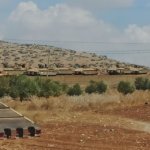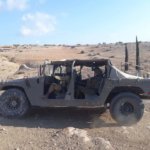Military Control
“Benyamin Netanyahu, 2001: “Nobody said what defined military zones were. Defined military zones are security zones; as far as I am concerned, the entire Jordan Valley is a defined military zone.” (1)
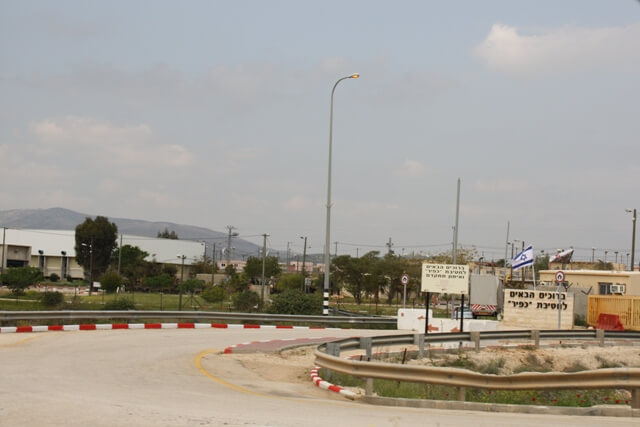 In total, 95% of the land in the Jordan Valley is off-limits to Palestinians: 50% is controlled by Israel’s illegal settlements, and the other 45% is military bases, ‘closed military zones’ and ‘nature reserves’ (areas controlled by the occupation, that Palestinians are refused access to). This matrix of oppression suffocates Palestinian life in the Valley and stifles traditional forms of subsistence farming and grazing undertaken by the Bedouin throughout history.
In total, 95% of the land in the Jordan Valley is off-limits to Palestinians: 50% is controlled by Israel’s illegal settlements, and the other 45% is military bases, ‘closed military zones’ and ‘nature reserves’ (areas controlled by the occupation, that Palestinians are refused access to). This matrix of oppression suffocates Palestinian life in the Valley and stifles traditional forms of subsistence farming and grazing undertaken by the Bedouin throughout history.
Btselem have produced a map showing the firing zones and ‘nature reserves’ in the Jordan Valley, which is available on their website at: http://www.btselem.org/sites/default/files/20110508_jordan_vally_nature_and_fire_zones_map_eng.pdf
Military bases
There are more than 20 military bases spread across the whole length of the Jordan Valley, taking up around 2% of the land, and ‘observation points’ constantly look down from the hilltops, surveilling every Palestinian community.
The bigger military bases have administration blocks, massive sheds full of tanks and jeeps, helicopter pads, and dormitories for the resident and visiting soldiers. They are situated nearer the main roads, for example on the Allon road near Samra, and in Al Jiftlik near Abel al Ajaaj.
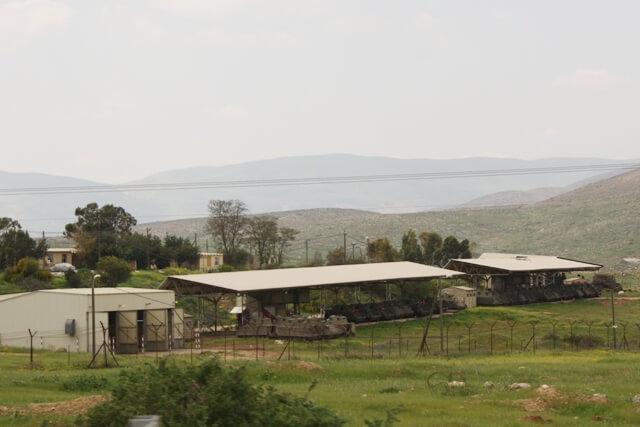 As you walk away from the main roads, and into the hills, you will happen upon yet more bases, hidden from sight. Many of these are disused, and held in reserve for ‘emergencies’, such as the base south of Bardala. Others are left to go derelict, and then handed over to settlers, such as the disused base near Maskiyyot settlement, which has now been handed over to the settlers as they expand still further.
As you walk away from the main roads, and into the hills, you will happen upon yet more bases, hidden from sight. Many of these are disused, and held in reserve for ‘emergencies’, such as the base south of Bardala. Others are left to go derelict, and then handed over to settlers, such as the disused base near Maskiyyot settlement, which has now been handed over to the settlers as they expand still further.
There are bases used exclusively for IOF administration, in Al Jiftlik and and Ein Hejla to the east of Jericho, plus the administration office of the District Coordination Office south of Jericho.
This network of observation posts and military bases gives the IOF complete control of the valley, and the ability to act how they want, where they want, and when they want.
Military training
 The Israeli Occupation army treats the whole Jordan Valley as its training ground. It has several locations throughout the valley which are effectively permanent training areas, where they run training exercises on a regular basis. For example:
The Israeli Occupation army treats the whole Jordan Valley as its training ground. It has several locations throughout the valley which are effectively permanent training areas, where they run training exercises on a regular basis. For example:
- on level ground near Al Hadidiya, you can see the mounds and trenches that they use for regular training;
- in the hills above Palestinian Bedouin homes in Al Maleh there are massive trenches dug out of the soil on the hill tops;
- in Khlat Ijmaeah, east of Tayasir, (see photo in email 19th June 2012) there is a training area constituted of a group of concrete buildings at the head of a valley (presumably intended to represent a Palestinian or southern Lebanese village) which is regularly used for their training exercises.
In addition to these semi-permanent training grounds, in any week of the year there will be hundreds of troops setting up temporary bases in the hills and running training exercises with absolute disregard for any families that may be living nearby. In the period from October 2011 to June 2012 they have:
- Destroyed the crops of a Palestinian farmer in Farisiya (March 2012)
- Injured a young shepherd named Yashsir in Al Maleh when they shot him in the side (April 2012)
- Forced 30 Palestinian families in Al Maleh area to evacuate their homes to leave the area free for their training (June 2012)
- Left unexploded munitions in the area – Alaa Eqab Daragme lost his right hand in late 2011 when an explosive went off.
Yet, they don’t go into the settlement areas or interrupt the lives of the illegal settlers in the valley.
Since Israel occupied the West Bank in 1967 they have killed 52 Palestinians in the Jordan Valley during military training exercises, and have injured more than 200.
Military training, and the dangers it represents, has become commonplace for Palestinians in the Jordan Valley. However, June saw the escalation of the nature of the training and the areas in which it takes place.
In early June 2012 the IOF increased the use of heavy tanks and live ammunition in their training exercises in the Al Maleh area. They also moved into Area B (where the Palestinian Authority has joint control under the Oslo accords) – carrying out their training in the centre of Ein Shibli village, next to a park where local people take their children to play and swim.
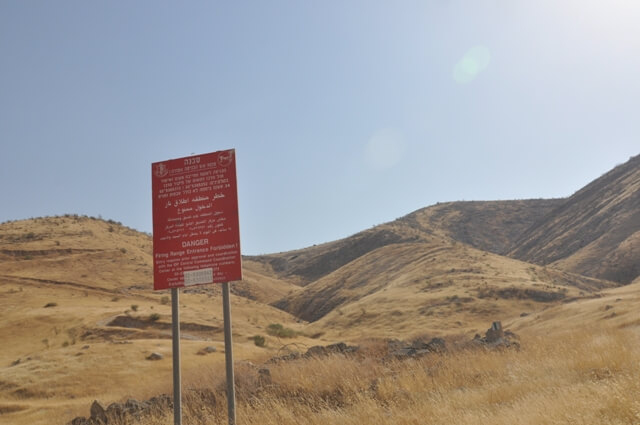 It seems that this is a clear message to the world that Israel intends to take absolute control over the valley, and are happy to violate Palestinian human rights if they wish. They have already designated 37% of the Jordan Valley as military training areas, but by their recent actions, are extending that sphere of control to the whole valley.
It seems that this is a clear message to the world that Israel intends to take absolute control over the valley, and are happy to violate Palestinian human rights if they wish. They have already designated 37% of the Jordan Valley as military training areas, but by their recent actions, are extending that sphere of control to the whole valley.
Danger: Firing Area Entrance Forbidden
In 2009 the occupation placed large concrete blocks by every road and dirt track that led to a Palestinian community in the valley, blocking off 85 roads in total. These blocks, distributed by the army, and stating: “Danger: Firing Area Entrance Forbidden” effectively confiscated all the Bedouin grazing land in the northern Jordan Valley, yet included absolutely none of the settlement land. Where people lived next to the roadside, as in Al Maleh, the blocks were placed just meters from their homes. They also placed some of the concrete blocks in Al Jiftlik, a Palestinian village with a population of around 5000 people, and confiscated land from right in the heart of the village.
 In other areas they’ve put up large red signs stating: “Danger: Firing Area Entrance Forbidden! Entry requires prior approval and coordination with the IDF (sic) Central Command Coordination Centre at the following telephone numbers. 025305042 or 025305511”.
In other areas they’ve put up large red signs stating: “Danger: Firing Area Entrance Forbidden! Entry requires prior approval and coordination with the IDF (sic) Central Command Coordination Centre at the following telephone numbers. 025305042 or 025305511”.
All these apartheid signs are intended exclusively for Palestinians, to prevent them from using the land and to put pressure on them to leave the area. They are a statement that if the IOF let off explosives, or shoot live ammunition, they will not be responsible for any harm to civilians in the area, whether they be men, women or children.
Nature reserves
20% of the Jordan Valley has been designated as ‘Nature Reserves’ by the occupation. All of this land is out of bounds for Palestinians, and 63% of it has been designated as ‘closed military areas’. Thus, Israel has attempted to green-wash its occupation by renaming military training areas as nature reserves. To justify this they have opened five small areas to visitors. As B’tselem state in their report: “This fact shows that Israel did not show great concern for the environment of the area…”.(2)
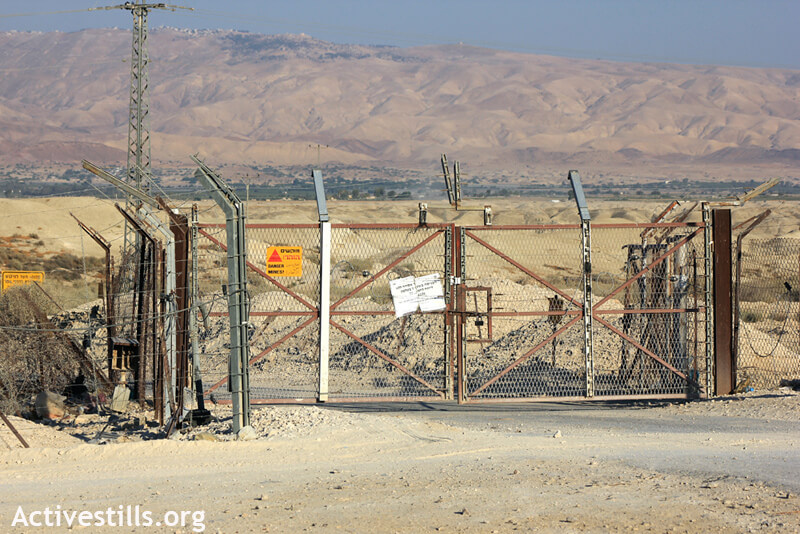 The prohibition of Palestinian use of land designated as nature reserves is enforced by confiscation of their animals, and the imposition of large fines for grazing their animals on the land. In one instance Palestinians were fined for picking a ‘protected’ plant in a nature reserve area.
The prohibition of Palestinian use of land designated as nature reserves is enforced by confiscation of their animals, and the imposition of large fines for grazing their animals on the land. In one instance Palestinians were fined for picking a ‘protected’ plant in a nature reserve area.
Closed area along the Jordan River
When Israel occupied the West Bank in 1967 they wasted no time in driving Palestinian farmers from the land near the Jordan River.
At that time the river flowed freely from the Galilee to the Dead Sea, fed by tributaries along the way. In this hot, dry landscape it was an essential source of water, and farmers had made their homes all along the river, benefiting from a reliable source of water, and some of the most fertile soil in the region.
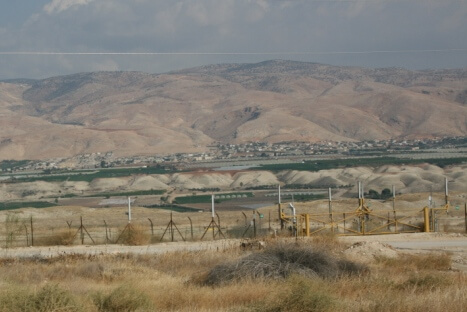 Having driven away the Palestinian population, Israel fenced off an area approximately 1km wide all along the section of the Jordan River that bordered the West Bank. Today, you can drive along Road 90, which runs along much of the fence, and you wouldn’t even know the Jordan River was there – it has been so decimated by over extraction of water, and so removed by the ‘security fence’.
Having driven away the Palestinian population, Israel fenced off an area approximately 1km wide all along the section of the Jordan River that bordered the West Bank. Today, you can drive along Road 90, which runs along much of the fence, and you wouldn’t even know the Jordan River was there – it has been so decimated by over extraction of water, and so removed by the ‘security fence’.
In recent years Jordan Valley Solidarity volunteers have reported an increase in sightings of Israeli settlers unlocking these gates and going onto the land, with bulldozers working the land and many new date plantations being developed behind fences which display signs warning of land mines. Settlers have keys which allow them free access through the gates segregating the ‘border zone’.
In reality, the Israeli government has been colonizing the area for years by supporting the construction of large over land reservoirs to hold water from the Jordan River while handing more Palestinian land to Jewish only agricultural colonies.
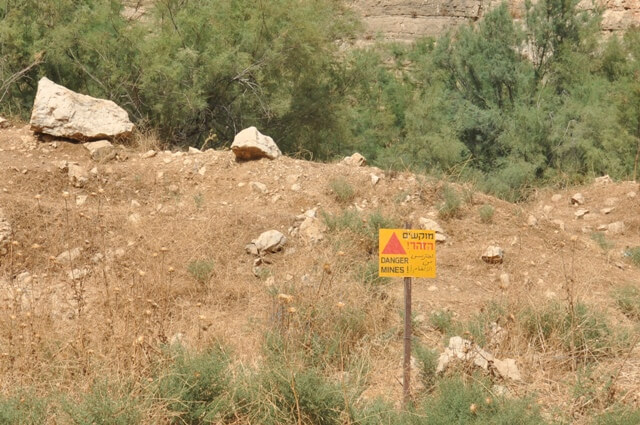 On 18th May 2012 Ynet news reported that the Israel Occupation Forces (IOF) have detonated 700 land mines in the Jordan Valley ‘border zone’. Ynet reported this as if it’s a great humanitarian act on the part of the Israeli Army, and in celebratory language boasted that the “border with Jordan will soon undergo a facelift”. However, for Palestinians living in the area it is clear that the land mines are being removed so that more of the land can be handed over to the settlements.
On 18th May 2012 Ynet news reported that the Israel Occupation Forces (IOF) have detonated 700 land mines in the Jordan Valley ‘border zone’. Ynet reported this as if it’s a great humanitarian act on the part of the Israeli Army, and in celebratory language boasted that the “border with Jordan will soon undergo a facelift”. However, for Palestinians living in the area it is clear that the land mines are being removed so that more of the land can be handed over to the settlements.
Summary
The IOF has taken control of all the land in the Jordan Valley that is still potentially available to Bedouin farmers to graze their cattle, sheep or goats, to draw water from natural springs, or to erect their tents to live in.
They live in a region that has been completely militarized in the past 45 years, with army bases, training grounds, military aircraft flying low overhead, checkpoints, the separation wall, demolitions and destruction.
 Thus, to survive independently any Palestinian farmer in the Jordan Valley has no choice but to go onto land that the occupation forces have declared as a ‘closed military zone’. Their only other options are to work as slave labour in one of Israel’s illegal settlements, or leave the area. Given Israel’s plan to forcibly remove all the Bedouin from the Jordan Valley it is clear that this escalation in the IOF’s military exercises are a sign of things to come. An international network of solidarity activists needs to mobilise quickly and effectively to oppose these dangerous developments and fight for Palestinian rights in the Jordan Valley. …………………..
Thus, to survive independently any Palestinian farmer in the Jordan Valley has no choice but to go onto land that the occupation forces have declared as a ‘closed military zone’. Their only other options are to work as slave labour in one of Israel’s illegal settlements, or leave the area. Given Israel’s plan to forcibly remove all the Bedouin from the Jordan Valley it is clear that this escalation in the IOF’s military exercises are a sign of things to come. An international network of solidarity activists needs to mobilise quickly and effectively to oppose these dangerous developments and fight for Palestinian rights in the Jordan Valley. …………………..

